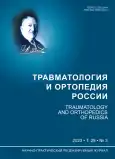Лечение пациента с ятрогенным повреждением лучевого нерва после остеосинтеза плечевой кости: клинический случай
- Авторы: Кисель Д.А.1, Файн А.М.1,2, Светлов К.В.1, Боголюбский Ю.А.1, Алейникова И.Б.1, Синкин М.В.1
-
Учреждения:
- ГБУЗ «Научно-исследовательский институт скорой помощи имени Н.В. Склифосовского Департамента здравоохранения г. Москвы»
- ФГБОУ ВО «Московский государственный медико-стоматологический университет имени А.И. Евдокимова» Минздрава России
- Выпуск: Том 29, № 3 (2023)
- Страницы: 110-117
- Раздел: Случаи из практики
- URL: https://ogarev-online.ru/2311-2905/article/view/255270
- DOI: https://doi.org/10.17816/2311-2905-7984
- ID: 255270
Цитировать
Аннотация
Актуальность. Ятрогенные нейропатии лучевого нерва после остеосинтеза диафиза плечевой кости штифтом с блокированием развиваются у 2,9% пациентов. При этом в 30% случаев ятрогенное повреждение нерва связано с дистальным блокированием штифта. Вопросы о сроках и объеме диагностических мероприятий, направленных на определение характера повреждения нерва, методах консервативного и хирургического лечения, их эффективности остаются актуальным.
Цель — на клиническом примере показать причины возникновения, методы профилактики, диагностики и лечения ятрогенных повреждений лучевого нерва при переломах плечевой кости.
Описание клинического случая. Пациентка 30 лет поступила с несросшимся переломом левой плечевой кости, ятрогенным повреждением лучевого нерва слева спустя 3 мес. после остеосинтеза перелома блокированным штифтом. Выполнена повторная операция: удаление штифта из левой плечевой кости; реостеосинтез левой плечевой кости пластиной; ревизия, невролиз, пластика левого лучевого нерва аутотрансплантатами из икроножного нерва справа. После операции проводили курсы медикаментозной терапии, физиотерапевтическое лечение, лечебную гимнастику. Через 26 мес. после операции наблюдали полную амплитуду и восстановление силы активного разгибания левой кисти и трехфаланговых пальцев, отведения первого пальца, неполную амплитуду разгибания первого пальца, восстановление чувствительности по наружной поверхности левого предплечья и тыльной поверхности кисти.
Заключение. Ятрогенное повреждение лучевого нерва происходит преимущественно в результате несоблюдения техники введения блокирующих винтов при остеосинтезе переломов диафиза плечевой кости штифтами. Несвоевременное обследование и оперативное лечение пациентов с поврежденным лучевым нервом приводит к невозможности полного функционального восстановления, потенциальной атрофии мышц, угнетению их двигательной функции. Оперативное лечение, направленное на восстановление лучевого нерва в ранние сроки после травмы, в сочетании с полным спектром послеоперационной реабилитации в течение года является единственно верным вариантом лечения.
Полный текст
Открыть статью на сайте журналаОб авторах
Дмитрий Александрович Кисель
ГБУЗ «Научно-исследовательский институт скорой помощи имени Н.В. Склифосовского Департамента здравоохранения г. Москвы»
Автор, ответственный за переписку.
Email: dkis@yandex.ru
ORCID iD: 0000-0002-5187-0669
SPIN-код: 7663-4031
научный сотрудник отделения неотложной травматологии опорно-двигательного аппарата
Россия, 129090, Москва, Большая Сухаревская площадь, д. 3Алексей Максимович Файн
ГБУЗ «Научно-исследовательский институт скорой помощи имени Н.В. Склифосовского Департамента здравоохранения г. Москвы»; ФГБОУ ВО «Московский государственный медико-стоматологический университет имени А.И. Евдокимова» Минздрава России
Email: finn.loko@mail.ru
ORCID iD: 0000-0001-8616-920X
доктор медицинских наук, руководитель отделения неотложной травматологии опорно-двигательного аппарата, профессор кафедры травматологии, ортопедии и медицины катастроф
Россия, 129090, Москва, Большая Сухаревская площадь, д. 3; МоскваКирилл Всеволодович Светлов
ГБУЗ «Научно-исследовательский институт скорой помощи имени Н.В. Склифосовского Департамента здравоохранения г. Москвы»
Email: svetloffkirill@yandex.ru
ORCID iD: 0000-0002-1538-0515
кандидат медицинских наук, ведущий научный сотрудник отделения неотложной травматологии опорно-двигательного аппарата
Россия, 129090, Москва, Большая Сухаревская площадь, д. 3Юрий Андреевич Боголюбский
ГБУЗ «Научно-исследовательский институт скорой помощи имени Н.В. Склифосовского Департамента здравоохранения г. Москвы»
Email: bo_y_an@mail.ru
ORCID iD: 0000-0002-1509-7082
кандидат медицинских наук, старший научный сотрудник отделения неотложной травматологии опорно-двигательного аппарата
Россия, 129090, Москва, Большая Сухаревская площадь, д. 3Ирина Борисовна Алейникова
ГБУЗ «Научно-исследовательский институт скорой помощи имени Н.В. Склифосовского Департамента здравоохранения г. Москвы»
Email: alejnikova_irina@mail.ru
ORCID iD: 0000-0003-4937-0400
кандидат медицинских наук, врач функциональной диагностики, нейрохирург
Россия, 129090, Москва, Большая Сухаревская площадь, д. 3Михаил Владимирович Синкин
ГБУЗ «Научно-исследовательский институт скорой помощи имени Н.В. Склифосовского Департамента здравоохранения г. Москвы»
Email: mvsinkin@gmail.com
ORCID iD: 0000-0001-5026-0060
кандидат медицинских наук, старший научный сотрудник, врач функциональной диагностики нейрохирургического отделения
Россия, 129090, Москва, Большая Сухаревская площадь, д. 3Список литературы
- Laulan J. High radial nerve palsy. Hand Surg Rehabil. 2019;38(1):2-13. doi: 10.1016/j.hansur.2018.10.243.
- Bumbasirevic M., Palibrk T., Lesic A., Atkinson H.D. Radial nerve palsy. EFORT Open Rev. 2017;1(8):286-294. doi: 10.1302/2058-5241.1.000028.
- Cognet J.M., Fabre T., Durandeau A. Persistent radial palsy after humeral diaphyseal fracture: cause, treatment, and results. 30 operated cases. Rev Chir Orthop Reparatrice Appar Mot. 2002;88(7):655-662. (In French).
- Ljungquist K.L., Martineau P., Allan C. Radial nerve injuries. J Hand Surg Am. 2015;40(1):166-172. doi: 10.1016/j.jhsa.2014.05.010.
- Rasulić L., Djurašković S., Lakićević N., Lepić M., Savić A., Grujić J. et al. Surgical Treatment of Radial Nerve Injuries Associated With Humeral Shaft Fracture-A Single Center Experience. Front Surg. 2021;8:774411. doi: 10.3389/fsurg.2021.774411.
- Schwaiger K., Abed S., Russe E., Koeninger F., Wimbauer J., Kholosy H. et al. Management of Radial Nerve Lesions after Trauma or Iatrogenic Nerve Injury: Autologous Grafts and Neurolysis. J Clin Med. 2020;9(12):3823. doi: 10.3390/jcm9123823. 7.
- Chang G., Ilyas A.M. Radial Nerve Palsy After Humeral Shaft Fractures: The Case for Early Exploration and a New Classification to Guide Treatment and Prognosis. Hand Clin. 2018;34(1):105-112. doi: 10.1016/j.hcl.2017.09.011.
- Вишневский В.А. Причины, диагностические ошибки при повреждениях периферических нервов конечностей. Запорожский медицинский журнал. 2014;85(4):50-55.
- Vishnevskiy V.A. Reasons and Diagnostic Errors in Cases of the Peripheral Nerves of Extremities Injuring. Zaporozhye Medical Journal. 2014;85(4):50-55. (In Russian).
- Боголюбский Ю.А., Файн А.М., Сачков А.В., Мажорова И.И., Ваза А.Ю., Титов Р.С. и др. Ятрогенные повреждения лучевого нерва при остеосинтезе плечевой кости. Профилактика, диагностика и лечение. Журнал имени Н.В. Склифосовского «Неотложная медицинская помощь». 2020;9(1):51-60. doi: 10.23934/2223-9022-2020-9-1-51-60.
- Bogolyubsky Y.A., Fayn A.M., Sachkov A.V., Mazhorova I.I., Vaza A.Y., Titov R.S. et al. Iatrogenic Damage to the Radial Nerve During Osteosynthesis of the Humerus. Prevention, Diagnosis and Treatment. Russian Sklifosovsky Journal «Emergency Medical Care». 2020;9(1):51-60. (In Russian). doi: 10.23934/2223-9022-2020-9-1-51-60.
- Боголюбский Ю.А., Файн А.М., Ваза А.Ю., Гнетецкий С.Ф., Мажорова И.И., Кишиневский Е.В. и др. Травматические и ятрогенные повреждения лучевого нерва при переломах диафиза плечевой кости. Практическая медицина. 2022;20(4):109-116.
- Bogolyubsky Y.A., Fain A.M., Vaza A.Y., Gnetetskiy S.F., Mazhorova I.I., Kishinevskiy E.V. et al. Traumatic and iatrogenic lesions of the radial nerve in fractures of humeris diaphysis. Practical Medicine. 2022;20(4):109-116.
- Temiz N.C., Doğan A., Kirik A., Yaşar S., Durmaz M.O., Kutlay A.M. Radial nerve injuries and outcomes: Our surgical experience. Ulus Travma Acil Cerrahi Derg. 2021;27(6):690-696. doi: 10.14744/tjtes.2020.34576.
- Kim D.H., Kam A.C., Chandika P., Tiel R.L., Kline D.G. Surgical management and outcome in patients with radial nerve lesions. J Neurosurg. 2001;95(4):573-583. doi: 10.3171/jns.2001.95.4.0573.
Дополнительные файлы













